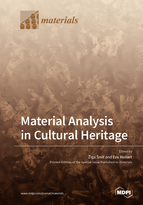Material Analysis in Cultural Heritage
A special issue of Materials (ISSN 1996-1944). This special issue belongs to the section "Advanced Materials Characterization".
Deadline for manuscript submissions: closed (20 December 2022) | Viewed by 24627
Special Issue Editors
2. Jožef Stefan Institute, SI-1000 Ljubljana, Slovenia
Interests: ion beam analysis; archaeological glass and metals; ionization models
Special Issues, Collections and Topics in MDPI journals
2. Jozef Stefan Institute, SI-1000 Ljubljana, Slovenia
Interests: non-destructive analysis; cultural heritage objects; material degradation; preventive conservation
Special Issues, Collections and Topics in MDPI journals
Special Issue Information
Dear Colleagues,
A Special Issue of Materials is devoted to the studies in the field of cultural heritage. Our ancestors have left us numerous spiritual and material remains and artefacts, and their understanding is important for functioning of the modern society. We are then bound to preserve and study our cultural heritage, which is quite challenging even by modern analytical methods. We therefore welcome all contributions that are dealing with studies of cultural heritage preservation and with analytical studies that would help us understand how our ancestors obtained raw materals, what production techniques they applied, how they traded with their products, how they used them and why some of them virtually accompanied them in their afterlife. Material analysis of heritage objects would then help us understand economic, political and social relations in ancient societies.
The authors are invited to sumbit manuscripts on the following themes:
- Environmental monitoring of the CH storage and display areas
- Degradation studies on the objects of CH
- Innovative conservation procedures
- Authenticity testing of CH objects and detection of forgery
- Application of dating techniques
- Development of specialized analytical techniques
- Studies of specific materials: arhaeological glass, metals, pigments, lithic materials
- Experimental archaeology, i.e., reconstruction of ancient techniques and materials
Prof. Dr. Žiga Šmit
Dr. Eva Menart
Guest Editors
Manuscript Submission Information
Manuscripts should be submitted online at www.mdpi.com by registering and logging in to this website. Once you are registered, click here to go to the submission form. Manuscripts can be submitted until the deadline. All submissions that pass pre-check are peer-reviewed. Accepted papers will be published continuously in the journal (as soon as accepted) and will be listed together on the special issue website. Research articles, review articles as well as short communications are invited. For planned papers, a title and short abstract (about 100 words) can be sent to the Editorial Office for announcement on this website.
Submitted manuscripts should not have been published previously, nor be under consideration for publication elsewhere (except conference proceedings papers). All manuscripts are thoroughly refereed through a single-blind peer-review process. A guide for authors and other relevant information for submission of manuscripts is available on the Instructions for Authors page. Materials is an international peer-reviewed open access semimonthly journal published by MDPI.
Please visit the Instructions for Authors page before submitting a manuscript. The Article Processing Charge (APC) for publication in this open access journal is 2600 CHF (Swiss Francs). Submitted papers should be well formatted and use good English. Authors may use MDPI's English editing service prior to publication or during author revisions.
Keywords
- analytical techniques in cultural heritage studies








